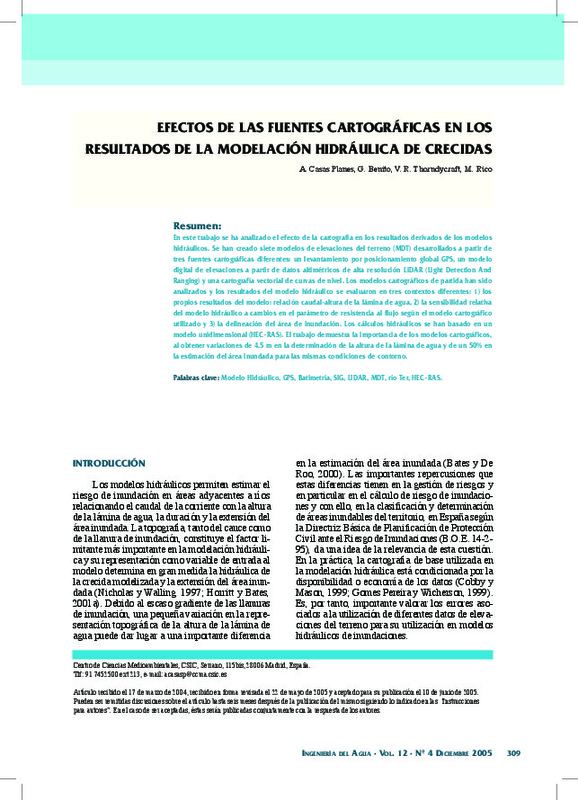Ackermann, F. (1999). Airborne laser scanning - present status and future expectations.
ISPRS Journal of Photogrammetry & Remote Sensing, 54, pp. 64-67.
Baltsavias, E.P. (1999). "Airborne laser scanning: basic relations and formulas". ISPRS Journal of Photogrammetry & Remote Sensing, 54, pp. 199-214.
[+]
Ackermann, F. (1999). Airborne laser scanning - present status and future expectations.
ISPRS Journal of Photogrammetry & Remote Sensing, 54, pp. 64-67.
Baltsavias, E.P. (1999). "Airborne laser scanning: basic relations and formulas". ISPRS Journal of Photogrammetry & Remote Sensing, 54, pp. 199-214.
Bates, P.B., Anderson, D.A, Price, D.A., Hardy, R.J., Smith, C.N. (1996). "Analysis and Development of Hydraulic Models for Floodplain Flows". En: Anderson, D.A, Walling, D.E. and Bates, P.B. eds. Floodplain Proceses, John Wiley & Sons Ltd.
Bates, P.B., De Roo, A.P.J. (2000). "A simple raster-based model for flood inundation simulation". Journal of Hydrology, 236, pp.54-77.
Bates, P.D., Marks, K.J., Horritt, M.S. (2003). "Optimal use of high-resolution topographic data in flood inundation models" Hydrological Processes, 17, pp. 537-557.
Bonham-Carter, G.F. (1996). Geographic Information Systems for Geoscientists - Modelling with GIS. Pergamon, Oxford.
Brasington, J., Rumsby, B.T., McVey, R.A. (2000). "Monitoring and modelling morphological change in a braided gravel-bed river using high-resolution GPS-based survey". Earth Surface Proceses and Landforms, 25, pp. 973-990.
Burrough, P.A., McDonnell, R.A. (1998). Principals of Geographical Information Systems, Oxford University Press.
Charlton, M.E, Large, A.R.G., Fuller, I.C. (2003). "Application of airborne LiDAR in River environments: The River Coquet, Northumberland, UK" Earth Surface Processes and Landforms, 28, pp. 299-306.
Chow V.T., Maidment D.R, Mays L.W. (1988). Applied Hydrology, MacGraw-Hill, Inc., New York.
Cobby, D.M., Mason, D.C. (1999). "Image processing of airborne scanning laser altimetry for improved river flood modeling". ISPRS Journal of Photogrammetry and Remote Sensing, 56, pp. 121-138.
Cobby, D.M., Mason, D.C., Horritt, M.S., Bates, P.D. (2003). "Two-dimensional hydraulic flood modelling using a finite-element mesh decomposed according to vegetation and topographic features derived from airborne scanning laser altimetry" Hydrological Processes, 17, pp. 1979-2000.
Fix R.E., Burt T.P. (1995). "Global Positioning System: an effective way to map a small catchment". Earth Surface Proceses and Landforms, 20, pp. 817-827.
French, J.R. (2003) "Airborne LiDAR in support of geomorphological and hydraulic modelling", Earth Surface Processes and Landforms, 28, pp. 321-335.
Gomes Pereira, L.M., Wicherson, R.J. (1999). "Suitability of laser data for deriving geographical information: a case study in the context of management of fluvial zones". ISPRS Journal of Photogrammetry and Remote Sensing, 54 (2-3), pp. 105-114.
Hardy, R.J., Bates, P.D., Anderson, M.G. (1999). "The importance of spatial resolution in hydraulic models for floodplain environments". Journal of Hydrology, 216, pp. 124-136.
Horritt, M.S. (2000). "Development of physically based meshes for two-dimensional models of meandering channel flow". International Journal for numerical methods in engineering, 47, pp. 2019-2037.
Horritt, M.S., Bates, P.D. (2001a). "Predicting floodplain inundation: rasted-based modelling versus the finite-element approach". Hydrological Processes, 15 (5), pp. 825-842.
Horritt, M.S., Bates, P.D. (2001b). "Effects of spatial resolution on a raster based model of flood flow". Journal of Hydrology, 253, pp. 239-249.
Hydrologic Engineering Center (1998a). HEC-RAS, River Analysis System User's Manual, Version 3.1, Davis, California.
Hydrologic Engineering Center (1998b). HEC-RAS Hydraulic Reference Manual, Davis, California.
Hydrologic Engineering Center (2002). HEC-GeoRAS: An extensión for support of HEC-RAS using Arcview User's Manual, Versión 3.1, Davis, California.
Keim, R.F., Skaugset, A.E., Bateman, D.S. (1999). "Digital terrain modeling of small stream channels with a total-station theodolite". Advances in water resources, 23, pp. 41-48
Lane S.N., Chandler J.H., Richards K.S. (1994). Developments in monitoring and terrain modelling small-scale river bed topography, Earth Surface Proceses and Landforms, 19, pp. 349-368.
Marks, K., Bates, P. (2000). "Integration of high resolution topographic data with floodplain flow models". Hydrological Processes, 14, pp. 2109-2122.
Martín Vide, J.P. (2002). Ingeniería de ríos. Ediciones UPC, Barcelona.
Navitronic Systems AS (1993). Navisound 50 Operators Manual, Denmark.
Nicholas, A.P., Walling, D.E. (1997). "Modelling flood hydraulics and overbank deposition on river flood-plains". Earth Surface Processes and Landforms, 22 (1), pp. 59-77.
Omer, C.R., Nelson, E.J., Zundel, A.K. (2003). "Impact of varied data resolution on Hydraulic Modeling and Floodplain Delineation". Journal of the American Water Resources Association, 39(2), pp. 467-475.
Raber, G., Jensen, J.R., Schill, J.R., Schuckman, K. (2003). "Creation of digital terrain models using an adaptive LiDAR vegetation point removal process" Photogrammetric Engineering and Remote Sensing, vol. 68, 12, pp. 1307-1315.
Ruiz, A.; González, X.; Herms, I. & Bastianelli, L. (2002). "Flood Risk Mapping Based on Airborne Laser Scanner Data: case of the Llobregat River". En: Proceedings of the Int. Conference on Flood Estimation, 6-8 March 2002, Bern, Switzerland.
Tate, E.C. (1999). Floodplain mapping using HEC-RAS and ArcView GIS, Center for Research in Water Resources, University of Texas at Austin.
Wehr, A., Lohr, U. (1999). "Airborne laser scanning-an introduction and overview" ISPRS Journal of Photogrammetry & Remote Sensing, 54, pp. 68-82.
Werner, M.G.F. (2001). Impact of grid size in GIS based flood extent mapping using a 1D flow model. Phys.Chem.Earth (B), Vol. 26, No 7-8, pp.517-522.
Wilson, M.D., Atkinson, P.M. (2003). "A comparison of remotely sensed elevation data sets for flood inundation modeling". Proceedings of the 7th International Conference on Geocomputation. University of Southampton, U.K.
[-]








